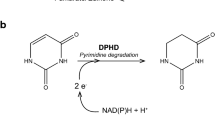Summary
Three tryptophan catabolites (tryptophol, indoleacetic acid and indoleacetaldehyde) were identified in the extracellular broths of deregulated mutants but not in that of the wild type. These compounds resulted from the degradation of excess tryptophan formed by the deregulated mutants. The mutants also produced 2 to 3 nonindolic compounds. Tryptophan was a minor product; tryptophol, the major broth metabolite. Among the deregulated strains, there were differences not only in the relative proportions but also in the spectra of the compounds produced. Tryptophol, indoleacetic acid and indoleacetaldehyde were produced by resting cells from added tryptophan or tryptamine. The presence of nonindolic compounds in the tryptophan-supplemented, but not tryptamine-supplemented, resting cell systems suggests that Hansenula polymorpha can degrade tryptophan by multiple pathways.
Similar content being viewed by others
References
Bolinder AE (1972) Large plate assays for amino acids. In: Kavanagh F (ed) Analytical Microbiology, vol II. Academic Press, New York, pp 479–591
Denenu EO, Demain AL (1981a) Derivation of aromatic amino acid mutants in a methanol-utilizing yeast, Hansenula polymorpha. Appl Environ Microbiol 41:1088–1096
Denenu EO, Demain AL (1981b) Enzymatic basis for the overproduction of tryptophan and its metabolites in Hansenula polymorpha mutants. Appl Environ Microbiol 42:497–501
Fantes PA, Roberts LM, Hütter R (1976) Free tryptophan pool and tryptophan biosynthetic enzymes in Saccharomyces cerevisiae. Arch Microbiol 107:207–214
Ganem, B (1978) From glucose to aromatics: recent developments in natural products of the shikimic pathway. Tetrahedron 34:3353–3383
Hartmann T, Glombitza KW (1967) Der trypophanabbau bei Rhizobium leugminosarum. Arch Mikrobiol 56:1–8
Held WA, Smith OH (1970a) Regulation of the Escherichia coli tryptophan operon by early reactions in the aromatic pathway. J Bacteriol 101:202–208
Held WA, Smith OH (1970b) Mechanism of 3-methylanthranilic acid derepression of the tryptophan operon in Escherichia coli. J Bacteriol 101:209–217
Hütter R (1976) Regulation of industrially important metabolic pathways. International School of General Genetics Vth Course: Microbial Breeding, Erice, Sicily
Jepson JB (1960) Indoles and related Ehrlich reactors. In: Smith I (ed) Chromatographic and Electrophoretic Techniques. Chromatography, vol 1. Interscience Publishers, New York, pp 183–211
Lim PG, Mateles RI (1964) Tryptophan- and indole-excreting prototrophic mutant of Escherichia coli. J Bacteriol 87:1051–1055
Makoto I, Shigeki M, Shoji M, Tairo O, Hiroshi W (eds) (1971) Metabolic Maps, 3rd edition. Kyoritsu Publishing Co, Ltd, Japan
Miozzari G, Niederberger P, Hütter R (1977) Action of tryptophan analogues in Saccharomyces cerevisiae. Arch Microbiol 115:307–316
Miozzari G, Niederberger P, Hütter R (1978) Tryptophan biosynthesis in Saccharomyces cerevisiae: control of the flux through the pathway. J Bacteriol 134:48–59
Rigaud R (1970) La biosynthese de l'acide indolyl-3-acetique en liaison avec le metabolisme du tryptophol et de l'indolyl-3-acetaldehyde chez Rhizobium. Physiol Plantarum 23:171–178
Rosazza JP, Juhl R, Davis P (1973) Tryptophol formation by Zygosaccharomyces priorianus. Appl Microbiol 26:98–105
Sabel'nikova VI, Dvornikova TP, Voloskova MM (1978) Transformation of L-tryptophan by Rhizobium phaseoli. Microbiol 46:780–784
Schürch A, Miozzari J, Hütter R (1974) Regulation of tryptophan biosynthesis in Saccharomyces cerevisiae: mode of action of 5-methyl-tryptophan and 5-methyl-tryptophan-sensitive mutants. J Bacteriol 117:1131–1140
Smith I (1960) Phenolic acids. In: Smith I (ed) Chromatograpic and Electrophoretic Techniques. Chromatography, vol 1. Interscience Publishers, New York, pp 291–307
Stecher PG, Windholz M, Leahy DS, Bolton DM, Eaton LG (1968) The Merck Index. An Encyclopedia of chemicals and drugs. 8th edition. Merck and Co., Inc. Rahway, NJ, p. 435
Terui G, Niizu H (1969) Recent studies on the fermentative production of L-tryptophan. Biotechnol Bioeng Symp 1:33–52
Young IG, Langman L, Luke RKJ, Gibson F (1971) Biosynthesis of the iron-transport compound enterochelin: mutants of Escherichia coli unable to synthesize 2,3-dihydroxybenzoate. J Bacteriol 106:51–57
Author information
Authors and Affiliations
Rights and permissions
About this article
Cite this article
Denenu, E.O., Demain, A.L. Relationship between genetic deregulation of Hansenula polymorpha and production of tryptophan metabolites. European J. Appl. Microbiol. Biotechnol. 13, 202–207 (1981). https://doi.org/10.1007/BF00500098
Received:
Issue Date:
DOI: https://doi.org/10.1007/BF00500098




